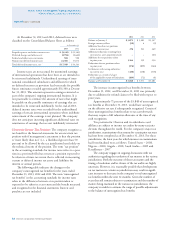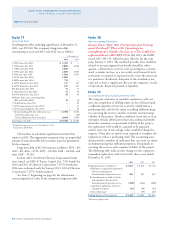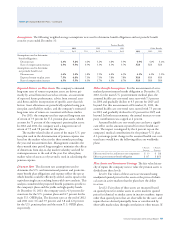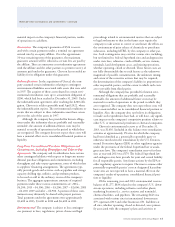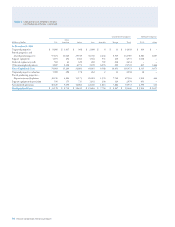Chevron 2013 Annual Report Download - page 63
Download and view the complete annual report
Please find page 63 of the 2013 Chevron annual report below. You can navigate through the pages in the report by either clicking on the pages listed below, or by using the keyword search tool below to find specific information within the annual report.
Chevron Corporation 2013 Annual Report 61
its U.S. plan and $350 to its international plans. Actual con-
tribution amounts are dependent upon investment returns,
changes in pension obligations, regulatory environments and
other economic factors. Additional funding may ultimately
be required if investment returns are insucient to oset
increases in plan obligations.
e company anticipates paying other postretirement
benets of approximately $215 in 2014, compared with $205
paid in 2013.
e following benet payments, which include estimated
future service, are expected to be paid by the company in the
next 10 years:
Pension Benets Other
U.S. Int’l. Benets
2014 $ 1,212 $ 284 $ 215
2015 $ 1,187 $ 290 $ 218
2016 $ 1,170 $ 284 $ 221
2017 $ 1,175 $ 363 $ 224
2018 $ 1,168 $ 391 $ 227
2019–2023 $ 5,399 $ 2,307 $ 1,148
Employee Savings Investment Plan Eligible employees
of Chevron and certain of its subsidiaries participate in the
Chevron Employee Savings Investment Plan (ESIP).
Charges to expense for the ESIP represent the company’s
contributions to the plan, which are funded either through
the purchase of shares of common stock on the open market
or through the release of common stock held in the leveraged
employee stock ownership plan (LESOP), which is described
in the section that follows. Total company matching con-
tributions to employee accounts within the ESIP were $303,
$286 and $263 in 2013, 2012 and 2011, respectively. is
cost was reduced by the value of shares released from the
LESOP totaling $140, $43 and $38 in 2013, 2012 and2011,
respectively. e remaining amounts, totaling $163, $243
e primary investment objectives of the pension plans
are to achieve the highest rate of total return within prudent
levels of risk and liquidity, to diversify and mitigate potential
downside risk associated with the investments, and to
provideadequate liquidity for benet payments and
portfolio management.
e company’s U.S. and U.K. pension plans comprise
88percent of the total pension assets. Both the U.S. and U.K.
plans have an Investment Committee that regularly meets
during the year to review the asset holdings and their returns.
To assess the plans’ investment performance, long-term asset
allocation policy benchmarks have been established.
For the primary U.S. pension plan, the company’s Bene-
t Plan Investment Committee has established the following
approved asset allocation ranges: Equities 40–70 percent,
Fixed Income and Cash 20–60 percent, Real Estate 0–15
percent, and Other 0–5 percent. For the U.K. pension plan,
the U.K. Board ofTrustees has established the following asset
allocation guidelines, which are reviewed regularly: Equities
40–60 percent, Fixed Income and Cash 25–50 percent and
Real Estate 5–15 percent. e other signicant international
pension plans also have established maximum and minimum
asset allocation ranges that vary by plan. Actual asset alloca-
tion within approved ranges is based on a variety of current
economic and market conditions and consideration of specic
asset class risk. To mitigate concentration and other risks,
assets are invested across multiple asset classes with active
investment managers and passive index funds.
e company does not prefund its OPEB obligations.
Cash Contributions and Benet Payments In 2013,
the company contributed $819 and $375 to its U.S. and
international pension plans, respectively. In 2014, the
company expects contributions to be approximately $350 to
e eects of fair value measurements using signicant unobservable inputs on changes in Level 3 plan assets are
outlined below:
Fixed Income
Mortgage-Backed
Corporate Securities Real Estate Other Total
Total at December 31, 2011 $ 27 $ 2 $ 998 $ 56 $ 1,083
Actual Return on Plan Assets:
Assets held at the reporting date – – 108 1 109
Assets sold during the period – – 2 – 2
Purchases, Sales and Settlements 4 – 182 – 186
Transfers in and/or out of Level 3 – – – – –
Total at December 31, 2012 $ 31 $ 2 $ 1,290 $ 57 $1,380
Actual Return on Plan Assets:
Assets held at the reporting date (9) – 90 – 81
Assets sold during the period – – 3 – 3
Purchases, Sales and Settlements 1 – 176 – 177
Transfers in and/or out of Level 3 – – – – –
Total at December 31, 2013 $ 23 $ 2 $ 1,559 $ 57 $ 1,641
Note 21 Employee Benefit Plans – Continued



